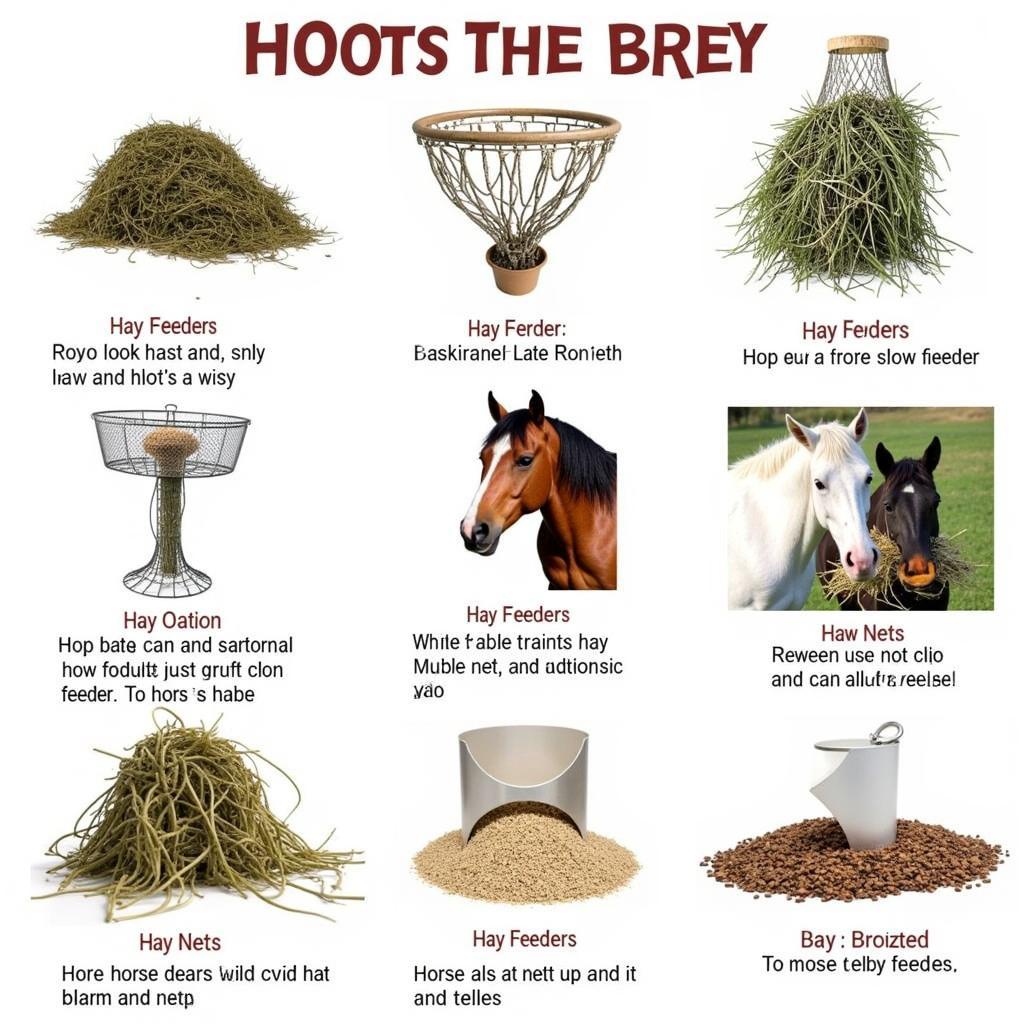Slow feeders for horses are essential tools for mimicking natural grazing patterns and promoting equine digestive health. They help prevent horses from consuming large amounts of food quickly, which can lead to a variety of health issues, including colic and obesity. Understanding the benefits and choosing the right slow feeder can significantly enhance your horse’s well-being.
Why Use a Slow Feeder for Horses?
Horses in the wild graze for up to 16 hours a day, constantly moving and consuming small amounts of forage. This natural grazing behavior contrasts sharply with the traditional feeding practices of domesticated horses, who often receive large meals twice a day. This abrupt change in feeding patterns can disrupt the horse’s digestive system, leading to health problems. Slow feeders help bridge the gap between natural grazing and domesticated feeding schedules, promoting a healthier digestive process. They also help alleviate boredom and reduce stress-related behaviors like cribbing and weaving. Investing in a slow feeder is a simple yet effective way to improve your horse’s overall health and happiness.
Using a slow feeder has numerous benefits, including:
- Improved digestion: Slow feeders encourage horses to eat smaller amounts of food over a longer period, mimicking natural grazing behavior. This promotes better digestion and reduces the risk of colic and other digestive issues.
- Weight management: By slowing down the rate of consumption, slow feeders can help prevent overeating and contribute to healthy weight management.
- Reduced boredom: The act of foraging for food in a slow feeder provides mental stimulation and can alleviate boredom, especially for horses stabled for extended periods.
- Reduced stress: The consistent access to forage provided by a slow feeder can reduce stress levels in horses, particularly those prone to anxiety.
After introducing a slow feeder, carefully monitor your horse’s behavior and adjust the feeding schedule as needed. Remember that every horse is an individual, and finding the right balance is key to maximizing the benefits of slow feeding.
Choosing the Right Slow Feeder for Your Horse
Selecting the appropriate slow feeder depends on various factors, including your horse’s individual needs, your budget, and your management style. There are numerous types of slow feeders available on the market, each designed with specific features and benefits.
Types of Slow Feeders
- Hay Nets: Slow feeder hay bags horses are a popular and cost-effective option, allowing horses to access hay slowly through small openings.
- Hay Feeders: Horse hay slow feeder come in various designs, from simple boxes with grids to more elaborate systems that mimic grazing on pasture.
- Grain Slow Feeders: Horse grain slow feeder are designed to slow down the consumption of grain, preventing bolting and promoting better digestion.
Considerations When Choosing a Slow Feeder
- Durability: Choose a slow feeder made from sturdy materials that can withstand wear and tear.
- Safety: Ensure the slow feeder is designed to minimize the risk of injury to your horse. Avoid sharp edges or protrusions that could cause cuts or scrapes.
- Ease of Cleaning: Select a slow feeder that is easy to clean and maintain to prevent the buildup of bacteria and mold.
- Size and Capacity: Choose a slow feeder that is appropriately sized for your horse and holds an adequate amount of forage.
How to Introduce a Slow Feeder to Your Horse
Introducing a slow feeder should be a gradual process to allow your horse to adjust to the new feeding method. Start by offering a small amount of hay in the slow feeder alongside the horse’s regular feed. Gradually increase the amount of hay in the slow feeder while decreasing the amount of hay provided in the traditional manner. Monitor your horse’s reaction and adjust the transition period as needed. Some horses may adapt quickly, while others may require more time to become accustomed to the slow feeder.
 Different Types of Horse Slow Feeders
Different Types of Horse Slow Feeders
“Patience is key when introducing a slow feeder,” advises equine nutritionist Dr. Sarah Miller. “Allowing your horse to adjust at their own pace will ensure a smooth transition and maximize the benefits of slow feeding.”
Are Slow Feeders Right for Every Horse?
While slow feeders offer numerous benefits, they may not be suitable for every horse. Horses with dental problems or certain medical conditions may require different feeding strategies. Consult with your veterinarian to determine if a slow feeder is appropriate for your horse’s individual needs.
“Remember, the goal of slow feeding is to mimic natural grazing patterns as closely as possible,” says experienced horse trainer John Davis. “This approach helps maintain a healthy digestive system and promotes overall well-being in horses.”
Conclusion
Slow feeders for horses are a valuable tool for promoting equine digestive health, reducing boredom, and managing weight. By understanding the different types of slow feeders available and following a gradual introduction process, you can help your horse reap the numerous benefits of this natural feeding approach. Investing in a slow feeder is an investment in your horse’s long-term health and happiness.
FAQ
- What are the benefits of using a Slow Feeder For Horses?
- What are the different types of slow feeders available?
- How do I introduce a slow feeder to my horse?
- Are slow feeders suitable for all horses?
- How do I choose the right size slow feeder for my horse?
- How often should I clean my horse’s slow feeder?
- Where can I purchase a slow feeder for my horse?
For further information on DIY slow feeders, check out our article: DIY Slow Feeder for Horses. We also have detailed guides on hay slow feeders and slow feeder hay bags for horses.
Need assistance? Contact us at Phone Number: 0772127271, Email: [email protected], or visit us at QGM2+WX2, Vị Trung, Vị Thuỷ, Hậu Giang, Việt Nam. We have a 24/7 customer service team ready to help.